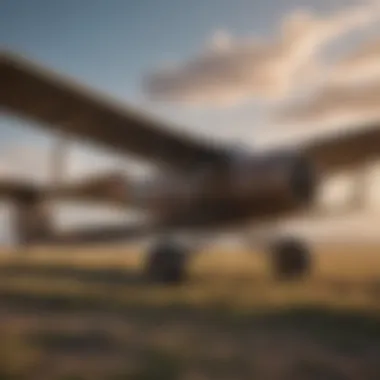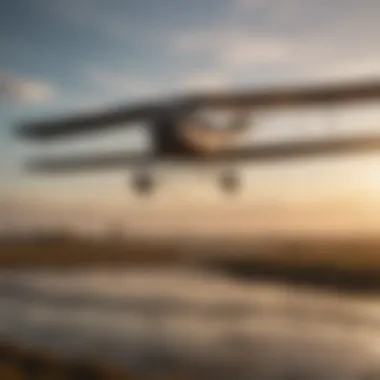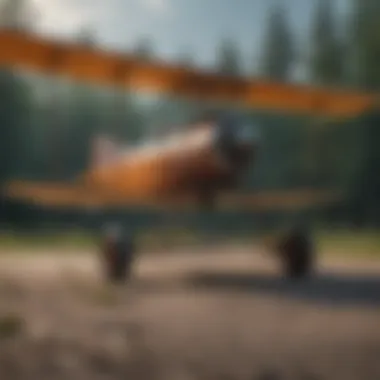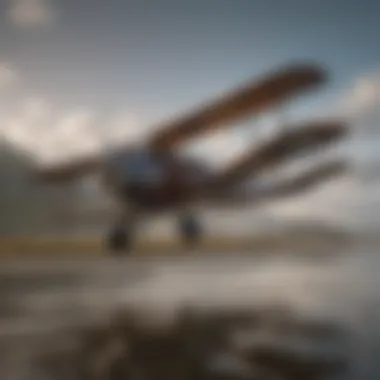The Wright Brothers and the Rise of Flight


Nature Topic Overview
In the vast expanse of the skies, the tales of flight begin not in the clouds but on solid ground, where two brothers, Orville and Wilbur Wright, took their first steps towards making their dream of flying come true. Their journey into the world of aviation was not just about building an airplane; it was a relentless pursuit of knowledge, innovation, and the sheer desire to make humanity soar.
From their childhood in Dayton, Ohio, the Wright brothers were always curious about how things worked. They constructed their first flying machine—an intricate contraption of wood and cloth—after years of experimentation, learning from failures, and devouring every bit of information about flight they could get their hands on. The Wrights faced challenges that would turn lesser minds away, but they learned from each setback.
Through their ingenuity, they eventually created the first powered aircraft, known as the Wright Flyer. On December 17, 1903, in Kitty Hawk, North Carolina, their dreams took wing. This was not just a flight; it was a monumental leap for mankind, changing the course of transportation forever. The success was built upon a foundation of scientific principles and rigorous testing.
How did they manage this incredible feat? Their story is filled with key ideas like the importance of lift, thrust, and balance, each element playing a critical role in the mechanics of their airplane.
Fun Facts and Trivia
- Did you know the Wright brothers built their own wind tunnel? It was a small wooden structure, but it helped them test their designs effectively!
- The first flight lasted only 12 seconds but covered 120 feet. That's about the length of a small room!
- Orville and Wilbur were not only inventors but also very good bicycle mechanics, which helped them understand balance when flying.
- Their first powered flight happened on a day that was incredibly cold—so cold, in fact, that Orville had to run across the snow!
These engaging facts are just the tip of the iceberg when it comes to understanding how the Wright brothers changed the world. From airplanes to the way we think about travel, their contributions resonate in our daily lives even today.
DIY Nature Activities
What if kids could dive into the world of aviation right from home? Here are some hands-on activities they can try:
- Build a Paper Airplane: Using simple materials, get creative and see how aerodynamic shapes affect flight distance.
- Create a Wind Tunnel Experiment: Use a fan and some small objects to see how air affects them and explore the principle of lift.
- Flight Journal: Keep track of results from your experiments, just like the Wright brothers did!
- Outdoor Flight Day: Find a local park, and spend a day flying your kites or paper airplanes.
Exploration and understanding are fundamental, especially when it comes to the science of flight. Just as the Wright brothers did, young explorers can learn to observe, experiment, and create their own pathways to the skies.
"Just because something is hard doesn’t mean you can’t do it. Sometimes you just have to keep trying until you figure it out."
Through engaging activities and a pinch of creativity, children can experience the spirit of innovation and the thrill of flight right at home!
Prologue to the Wright Brothers
The story of the Wright Brothers is a pivotal piece of aviation history, highlighting how innovation and determination can defy gravity, quite literally. This section serves as a gateway into the lives and contributions of Orville and Wilbur Wright, guiding readers through their beginnings and the principles that fueled their groundbreaking work. Understanding the Wright Brothers is crucial to grasping the evolution of flight and its significance in our world today.
The Early Years
Childhood in Ohio
Born in Dayton, Ohio, the Wright Brothers were shaped by their Midwestern upbringing. Not far from natural wonders, they grew up in a family that highly valued education and curiosity. Their parents, Millicent and Bishop Wright, encouraged their boys to explore various interests, blending academics with hands-on learning. Ohio's landscape, teeming with open fields and the occasional gentle hill, provided a splendid backdrop for activities that would later inspire their aerial ambitions. The openness of the region meant there was plenty of space to tinker and experiment, a unique feature that spurred creativity in their earliest days.
Inspiration from Flight
The skies above the Ohio landscape filled young Orville and Wilbur with dreams of soaring. Even as children, they were intrigued by flying objects. One particular memory stands out: their mother gifting them a toy helicopter that was powered by a rubber band. This small gift sparked a fascination with the mechanics of flight, igniting what would become a lifelong passion for aviation. It’s the blend of play and curiosity familiar in childhood that had profound implications in their later work. This inspiration set the stage for a journey that would change the course of history.
Shared Interests in Mechanics
Orville and Wilbur were not just dreamers; they were doers. Both showed a knack for mechanical skills from a young age, often taking apart and rebuilding their toys. Their shared interest in mechanics wasn't just a pastime, but a solid foundation for their future innovations. This hands-on approach to understanding how things work fueled their ambition, allowing them to grow closer as brothers. It was this bond that bolstered their collaborative spirit, a characteristic vital to their success.
Foundations of Innovation
Education and Practical Experiences
The Wright Brothers' educational journey was not conventional. While they did attend formal schooling, much of their knowledge came through self-directed learning. They voraciously read about flight and mechanics and gathered practical experiences by working in jobs that demanded critical thinking and engineering principles. This self-education allowed them to view challenges differently and develop a problem-solving mindset early on.
Early Inventions and Their Significance
Before even thinking about powered flight, the Wright Brothers dabbled in various inventions like a printing press and a bicycle shop. Their bicycle endeavor was particularly significant, as it honed their skills in design and craftsmanship. The principles of balance and control they learned through cycling would later become crucial in flight mechanics. Engaging in these early inventions not only diversified their skills but also laid the groundwork for the innovations that would propel them into the history books.


The Path to Powered Flight
The path to powered flight is not just about the mechanics of aviation; it's a quintessential part of the Wright brothers' story that showcases their relentless pursuit of innovation. Understanding this journey reveals the intricate blend of determination, experimentation, and ingenuity that propelled them toward success. It serves as a crucial narrative arc in this article, illustrating how every setback and every breakthrough fit into the larger framework of their aviation journey.
Initial Experiments
Glider Designs and Testing
The initial experiments with glider designs were a watershed moment for the Wright brothers. They began developing gliders not only to test their theories but to refine their understanding of aerodynamics. By launching their glider from a hill, they could observe how changes in the design affected its flight. The key characteristic of these early gliders was their emphasis on control and stability. The Wright brothers realized that if they were going to fly, they first needed to master these fundamental elements.
One unique feature of their gliders was the ability to adjust the warp of the wings. This meant they could change the shape of the wings during flight, which was revolutionary at the time. The advantage of this design was clear; it allowed for better maneuverability in the air, which is critical for any kind of sustained flight. However, these gliders weren't perfect. They faced issues with lift and control, which resulted in several crashes and lessons learned.
"A glider is not merely a toy; it’s a platform for learning the fine art of balance between lift and drag."
Wind Tunnel Research
Wind tunnel research was another cornerstone of the Wright brothers' experiments. They built their own wind tunnel in their home workshop, which was rather unorthodox compared to what others were doing at the time. This wind tunnel allowed them to test small models of their aircraft designs, adjusting shapes and angles without the risks of actual flight.
A key characteristic of this research was its experimentation with various wing shapes and sizes. By using the wind tunnel, they could simulate the aspects of flight in a controlled environment. This method proved extremely beneficial because it enabled them to gather data and modify their designs before any full-scale attempts at powered flight.
The unique advantage of the wind tunnel was the ability to fine-tune their concepts with precision. While it consumed time and resources, the extensive data they collected ultimately provided the foundation for their successful designs. On the downside, constructing and maintaining a wind tunnel required a substantial commitment, often detracting from other critical tasks like engine development.
Developing the Engine
Challenges in Engine Design
The engine was the heart of their powered aircraft, and developing it posed significant challenges. The Wright brothers recognized that existing engines were too heavy for flight, which spurred them to design their own lightweight engine. This was crucial for the success of their aircraft and their dream of powered flight.
The main challenge the brothers faced was balancing power and weight. A lightweight engine needed to generate enough thrust without adding unnecessary bulk. They opted for a design that utilized a unique type of aluminum alloy that was not only lighter but also robust enough to withstand the rigors of flight. This innovation was necessary, ensuring that their aircraft could soar rather than plummet.
That said, engine design was tricky. There were numerous failures before they found a working solution, resulting in lost time and resources. However, the iterative process also meant that every failed attempt brought them closer to a successful engine.
Collaboration with Local Mechanics
Collaboration with local mechanics played a vital role in overcoming the hurdles of engine design. The Wright brothers often reached out to their neighbors who were skilled at working with engines, tapping into their expertise to solve practical issues.
This aspect of collaboration showcased the importance of community in their journey. Not only did it provide them with insights they may not have considered, but it also fostered a spirit of cooperation that was crucial during those early, formative years. The knowledge gained from these mechanics oftentimes accelerated their progress.
However, depending on others for technical support did introduce a measure of risk, particularly if their collaborators misunderstood the aerodynamics or operational requirements. The challenge lay in ensuring that their vision for flight translated accurately to the work done by hands outside their inventive minds.
The path to powered flight, although fraught with challenges, underscored the Wright brothers' innovative spirit and their unwavering determination to bring their dreams of aviation to life. Understanding this journey lays the groundwork for appreciating the monumental strides they made in shaping the world of flight.
The Historic First Flight
The story of the Wright Brothers pivots around a single, momentous occasion—their first powered flight. This event marked not just a personal triumph for Orville and Wilbur but a significant turning point in human history. A successful flight indicated the real possibility that humankind could conquer the skies, forever altering transportation, warfare, and how people perceive distances.
December Nineteenth, Nineteen Oh Three
Location and Conditions
The scene of the first flight was the windy beach of Kitty Hawk, North Carolina. This spot was no accident. Kitty Hawk is known for its consistent winds, which provided an ideal environment for flight experimentation. Those breezy conditions played a vital role in helping the Wright Brothers lift their Flyer off the ground.
What made Kitty Hawk particularly beneficial was its soft sands and remote location. These features created a relatively safe area for testing, far away from prying eyes that might laugh at their failures. Plus, the gentle slopes of the dunes allowed them to conduct gliding tests even before their engine was ready. Overall, the locale's wind and geography perfectly matched their needs, helping transform dreams of flight into reality.
The Flight Itself
On that fateful day, the Wright Flyers soared for the first time. Orville piloted the plane, and it stayed airborne for a whole twelve seconds, traveling about one hundred twenty feet. This short flight, though seemingly modest, represented countless hours of hard work, trial, and error. It was the moment when man first defied gravity, if only for a blink.


The unique characteristic of their aircraft was its balanced control, which allowed for maneuverability. Unlike earlier attempts at human flight, the Flyer established the foundation for modern airplane designs. Despite setbacks, the machine remained intact, showing that with resilience, even grand ideas can take flight.
Significance of the Flight
Public Reaction
The reaction to the first successful flight was both awe and skepticism. Onlookers, including a few passersby, were amazed to witness such a marvel. News of the flight traveled like wildfire, spurring imagination, curiosity, and often skepticism.
The public sometimes regarded the Wright Brothers as dreamers, not fully grasping the potential of powered flight. Yet, this flight started shifting perceptions about what was possible, igniting the curiosity of inventors, scientists, and the general populace.
Impact on Future Aviation
The ripple effects from that December day in 1903 were monumental, laying the groundwork for future aviation. The innovations that emerged from their work would evolve into today's sophisticated airplanes that traverse the globe. The lessons learned during their first flights helped direct the next generation of aviators, engineers, and inventors to approach the challenge of flight with better designs and ideas.
Technical Innovations
Understanding the technical innovations developed by the Wright brothers is crucial to appreciate their role in the history of aviation. Their work laid the foundation for modern flight, introducing principles and technologies that are still relevant today. Among these innovations are the flight control systems and materials designed for their aircraft, which helped them tackle the inherently challenging task of achieving powered flight.
Flight Control Systems
Canard Configuration
A notable aspect of the Wright brothers' approach was the canard configuration they used in their early aircraft designs. In simplest terms, canard refers to a small wing, or an additional lifting surface, placed at the front of the airplane. This configuration allowed the plane to be more controllable during flight. It enhanced stability and provided better lift distribution which made stayin' up in the air much easier.
One reason many engineers and pilots favored this design is its effective way of balancing the aircraft while still keeping it lightweight. The canard design helped distribute airflow more evenly along the airplane, improving lift while reducing drag. However, there are some trade-offs. The canard can lead to a stall if mismanaged, where the main wings lose lift before the canard, causing a potentially dangerous situation for the pilot. Despite this drawback, its benefit in stability and control helped set the stage for future developments in aircraft design.
"The canard configuration demands careful management, but when executed right, it pays dividends in control and stability."
Three-Axis Control
Moving to another critical innovation—the three-axis control system. This system allows pilots to maneuver the aircraft effectively in three dimensions: yaw, pitch, and roll. By controlling these three axes, a pilot can turn left or right, ascend or descend, and tilt the wings side to side. This was a game-changer for the Wright brothers.
By implementing this system, they transformed the way pilots interacted with their planes. The three axes provided a robust framework for controlling the aircraft’s movement, making flying more intuitive. A main characteristic of this system is its simplicity; it connects directly to the pilot through the use of levers and cables. However, while it greatly improves responsiveness, it also demands skilled handling from the pilot to prevent over-controlling, which could lead to complications in flight.
Materials and Design
The materials and design of the Wright brothers' aircraft also played an important role in their breakthroughs. Choosing the right materials was key; they had to be strong yet light to ensure successful flight without excessive weight.
Weight Considerations
One of the main factors they considered was weight. Lighter materials could allow for more efficient flight without requiring enormous power from the engine. For instance, the Wright brothers utilized spruce, a type of wood known for its lightweight properties. This choice made it easier to construct the frame of their aircraft without compromising too much strength.
Balancing weight was not without its challenges. A heavier aircraft may have needed a more powerful engine, which could introduce additional complications in the design. The quest for reducing weight ever so slightly was essential in achieving longer flight duration and sustainable flight path. However, slight misjudgments in weight distribution could easily affect the plane's balance, making it a fine line to walk.
Construction Techniques
Finally, the construction techniques used in the making of their flying machines also carved a niche for their legacy. The Wright brothers employed methods like wing-warping, which allowed them to control the aircraft's direction and stability effectively. This technique involved twisting the wings slightly to manage the aircraft's tilt and yaw, helping to navigate turns and adjust the balanc.
What uniquely characterized their construction methods was the use of simple, reliable techniques that didn't require sophisticated equipment. This made it accessible for many back in those days. A major advantage here was that it could be replicated or modified by others, leading to more advancements in aviation thereafter. Of course, the downside was that these techniques required constant refinement as aviation technology progressed.
Legacy of the Wright Brothers
The legacy of the Wright Brothers is a far-reaching narrative that encapsulates not just the creation of the first successful powered airplane but also the broader impact their innovations had on aviation as a whole. These two brothers from Ohio faced countless hurdles, yet their perseverance and ingenuity laid down the groundwork for modern aerial travel. Their story doesn't just end with a flight at Kitty Hawk; it branches out into advancements in technology, inspiration for future pioneers, and cultural significance that resonates even today.
Advancements in Aviation
Later Achievements


The later achievements of the Wright Brothers offered profound contributions to the aviation world. After their initial success in 1903, they didn’t just sit back and enjoy the glory. They continued to refine their designs, leading to the creation of the Wright Flyer II and III, which demonstrated improved control and stability during flight. The key characteristic of these achievements is the focus on practical applications for their concepts, proving that their methods could not only get a plane into the air but keep it there efficiently.
One unique feature of their later endeavors was the attention they paid to control mechanisms, showcasing their proactive approach towards aviation safety. This led to the development of a reliable flight control system that would influence all future aircraft design. The advantage of these advancements is clear: they provided a critical understanding of aerodynamics that others would build upon, making aviation an accessible reality for generations to come.
Inspiration to Future Generations
The Wright Brothers’ legacy serves as a glowing beacon of inspiration for young inventors and dreamers. Their determination and innovative spirit encourage young learners to pursue their passions in science and technology. The key characteristic of this inspiration is its universal appeal; it speaks to anyone with a dream, regardless of their background.
A notable aspect of their story is how they transformed failures into learning experiences, highlighting the importance of resilience. This lesson, while specific to their journey, is broadly applicable in many life scenarios. The advantages of this narrative lie in its ability to motivate children to think critically and creatively. By learning about the Wright Brothers, young minds can grasp not only historical facts but also important life lessons about hard work and the power of teamwork.
Cultural Impact
Representation in Media
The representation of the Wright Brothers in various media forms significantly contributes to our collective understanding of their impact. Movies, books, and documentaries often dramatize their achievements, bringing their story to life for modern audiences. The key characteristic of these representations is how they blend factual history with engaging storytelling, captivating hearts and minds alike.
One unique feature of their media portrayals is the emphasis on their humble beginnings, making it relatable to young audiences. This advantage lies in its ability to illustrate that greatness can come from modest origins, inspiring a new generation to dream big. Whether it’s a children’s book or a blockbuster film, the media often conveys their unwavering determination, which resonates deeply with those who dare to aspire.
Commemoration of Their Achievements
Commemoration of the Wright Brothers’ achievements reflects the respect and admiration they earned throughout history. Various monuments and museums across the USA, including the National Air and Space Museum, stand as a reminder of their accomplishments. The key characteristic of these commemorations is their commitment to preserving history in a way that educates and inspires future generations.
One striking aspect is the annual celebrations of their first flight, where communities come together to honor their legacy. This not only fosters a sense of unity but also keeps the spirit of innovation alive. The advantage of these commemorations is that they not only serve as a reminder of the past but also spark curiosity in the young minds of today, encouraging them to explore the realms of science and technology deeply.
"The engines of our future are fueled not just by ideas but by the stories of those who dared to take flight."
Ultimately, the legacy of the Wright Brothers is an intricate tapestry of invention and inspiration. Their quest for powered flight didn't just change the world; it reshaped how we think about the capabilities of humanity. With each new takeoff in the present, we stand on their shoulders, reaching for the stars.
Connecting to Young Learners
Lessons in Innovation
Encouraging Creativity and Problem Solving
The Wright brothers' journey to flight underscores the power of creativity and problem solving, an aspect that resonates well with young minds. Oftentimes, kids are natural thinkers, constantly questioning and seeking solutions to various puzzles in their world. By studying how Orville and Wilbur tackled each challenge on the path to powered flight, children can find inspiration in their own lives. The brothers faced numerous hurdles, from failed attempts to faulty designs, but they embraced each setback as a stepping stone rather than a stumbling block.
This mindset cultivates an environment where creative thinking is encouraged. When youngsters realize that mistakes can lead to breakthroughs, they build resilience. This is crucial because creativity in problem-solving fosters innovation, not just in aviation but in all aspects of life. It’s about keeping an open mind and being willing to try, try again, figuring out what works. Moreover, the Wright brothers also demonstrated that collaboration can amplify creativity. When children work together, share ideas, and brainstorm solutions, they often come up with unique innovations that they might not discover alone.
Importance of Perseverance
Perseverance stands tall in the virtue of great inventors, including the Wright brothers. Their story shows how sticking to a goal can lead to remarkable achievements. Many times, they dealt with failures that would discourage most people. Their first powered flight was a mere 12 seconds long, hardly something to celebrate, yet they pressed on. This teaches children an invaluable lesson: achieving great things doesn't happen overnight.
The characteristic of dedication is vital for success in any field. By reading about the struggles and triumphs of the Wright brothers, young learners can appreciate that hard work and commitment eventually pay off. It's important for them to understand that even the most successful individuals faced setbacks. Perseverance can be an empowering trait that motivates kids to chase their dreams, regardless of the challenges. What’s more, their journey shows that it's okay to stumble while trying to achieve something significant; what truly matters is one’s ability to rise again and move forward.
Exploring the World of Flight
Understanding Basic Aerodynamics
The principle of basic aerodynamics is essential for grasping how flight works. Starting with the four forces of flight—weight, lift, thrust, and drag—kids can better appreciate the scientific foundation of aviation. This aspect simplifies complex ideas in a manner that is accessible to younger audiences. Understanding how these forces interact not only demystifies flight but also encourages curiosity about science and physics.
Another engaging feature of aerodynamics is its hands-on learning potential. Kids can experiment with paper airplanes or simple models, providing a tangible way to explore these concepts. This hands-on engagement cultivates interest and solidifies understanding by turning theory into practice.
Engaging with Aviation History
Diving into aviation history not only connects children to the past but also instills a sense of wonder about human innovation. By learning about milestones such as the Wright brothers' first flight, they can connect stories of perseverance and technological advancement that shaped the world today. With a bit of storytelling, history can become more relatable and inspiring.
History fosters a sense of continuity, ensuring that young learners appreciate the advancements that came before them. While studying aviation history, children can identify figures and experiments that led to modern aviation, such as groundbreaking designs and inventions by pioneers like Amelia Earhart or Charles Lindbergh.
Connecting these dots helps children understand that history isn't just a string of dates—it's a collection of stories filled with trials, triumphs, and blood, sweat, and tears that paved the way for future aviation enthusiasts. This connection can motivate them to pursue their own passions, whether it's in science, history, or engineering.
"Innovation is taking two things that exist and putting them together in a new way." - Tom Peters
Through these explorations, both creativity and historical knowledge intertwine, setting the stage for a future generation that appreciates the marvels of aviation.







